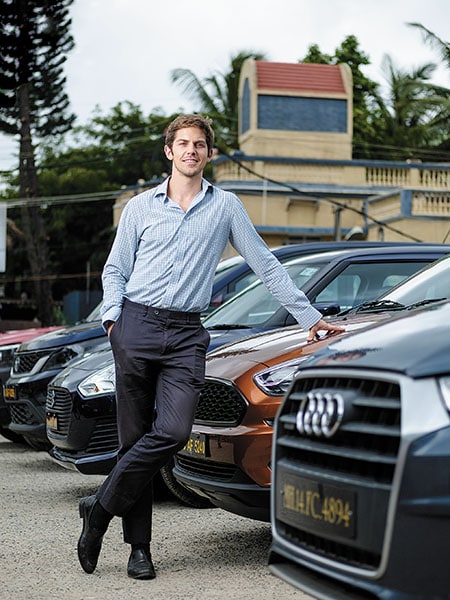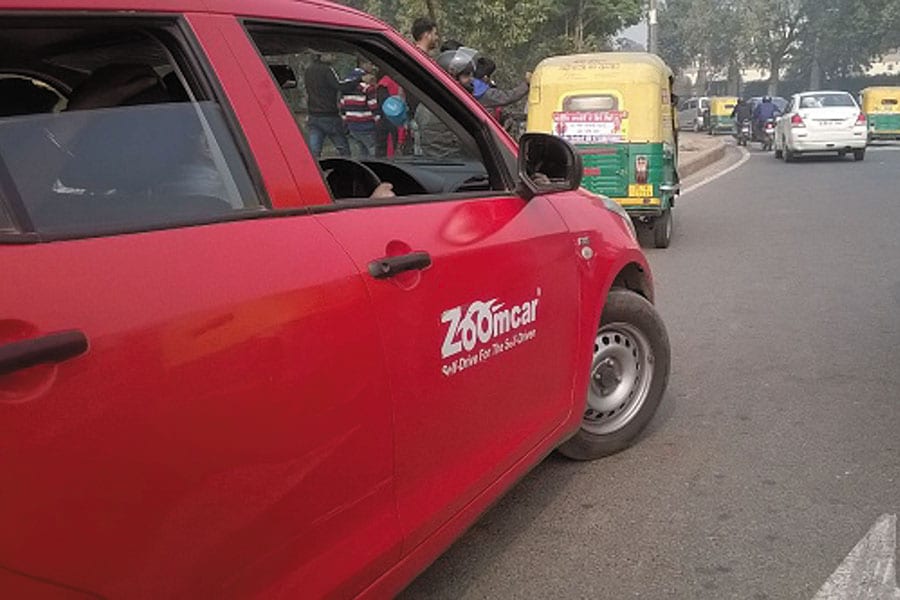
The pandemic has been the perfect tailwind: Zoomcar CEO
Greg Moran, CEO of Zoomcar, on why it's boom time for subscription-based mobility and getting business back to pre-Covid levels
 Greg Moran
Greg Moran
Image: Nishant Ratnakar for Forbes India
If you have cycled into a headwind, then making the most of the tailwind becomes a lot easier. Nobody perhaps knows it better than Greg Moran, who zoomed into gusty headwinds the moment he co-founded Zoomcar, a self-drive car rental platform, in 2013 in Bengaluru. To start with, there was an operational challenge. Zoomcar didn’t have a licence. Reason: The Contract Carriage Permit meant that the startup needed to have vehicles with yellow board licence plates. “But we didn’t have a fleet,” recalls Moran. There were other issues too. Zoomcar had raised seed funding, tied up with several carmakers, and Moran had put in all his savings. “It was a make-or-break situation,” he recounts. After navigating the existential crisis, came another one: Consumer mindset. “Car rentals were a completely unheard-of category when we started,” says Moran, chief executive officer of Zoomcar. The startup, subsequently, added heft to its operations by roping in marquee investors such as Mahindra & Mahindra, Ford Smart Mobility, Sequoia and Sony Innovation Fund.
Cut to 2020. After battling headwinds for four years, Moran found the perfect tailwind. While the pandemic has been challenging for people at a personal level, Zoomcar has fortunately been one of those businesses that has seen the tailwind, he points out. “I expect the boom time to continue for subscription-based mobility. We have seen a consistent 4-5x jump every week for the past three months,” he tells Forbes India. Edited excerpts:
Q. The pandemic is the demonetisation moment for your business as shared mobility has taken a hit…
Yes. This is an interesting time for our business because everyone is in a constant state of evolution. At Zoomcar, we have always been focussed on personal mobility. We have never been one of those traditional shared mobility companies that has focussed on vehicle plus the driver. Ola, Uber, Rapido, Shuttl type of platforms focussed on a shared model where you have multiple passengers with a driver. In times like Covid, it is going to be very, very tough for such models. And it’s not just because of the hygiene, sensitisation, or Covid. It’s also about disposable income. One of the important points that people forget is that personal mobility solutions like self-drive for cars and two-wheelers are much more affordable. So for middle-class people—especially when there are layoffs, and unemployment rates are skyrocketing—disposable incomes have taken a big hit. This plays really well for our type of solution, because you are able to deliver something well which is sanitised, clean, personalised, private as well as affordable. So that is one of the macro tailwinds which is helping as we emerge from the pandemic.
Q. Since 2013, you have been driving home the futility of owning an asset. The pandemic has helped people realise that…
There has been a strong tipping point. There’s been a dramatic upsurge in demand for subscription. While there are smaller players who offer this, we have about 85 percent market share within subscription. We have seen a consistent 4-5x jump every week over three months. The challenge is the supply side not having enough inventory. We have hit a supply wall over the last few weeks… we are working with our partners to fix this.
Q. A validation for your business model comes from Maruti, India’s biggest carmaker, which recently rolled out a subscription model…
Maruti’s model is quite different from ours. What Maruti is doing is much more like a lease. It is terming it as a subscription, but without getting into semantics, it is a financial lease product that is a little more flexible and convenient than a typical financing. We offer an end-to-end digital solution, right from the entire sales to the mobile app journey. The ability to share back the vehicle and reduce the cost is unique to Zoomcar. And that’s the big value proposition where you can reduce the cost by 50 percent of the whole subscription price. So instead of taking a Swift, for say ₹18,000 a month, you pay between ₹5,000 and ₹7,000 a month. We have integrated our entire Internet of Things (IoT) stack into the subscription as a service and our products come equipped with real-time drive score, vehicle health scoring and royalty programme which allows you to save additionally on your monthly subscription, and fuel costs. We are building an ecosystem as a platform where we are in a much more 360-degree standpoint for about an entire lifestyle and much more than a transactional leasing type of service.
 Zoomcar’s biggest markets are metros like Bengaluru, Delhi, Mumbai, Chennai, Kolkata and Ahmedabad, and the company does not intend to expand further this year
Zoomcar’s biggest markets are metros like Bengaluru, Delhi, Mumbai, Chennai, Kolkata and Ahmedabad, and the company does not intend to expand further this yearImage: Pradeep Gaur / Mint via Getty Images
Q. Have layoffs and salary cuts resulted in down-trading? And have you rolled out a low-period subscription plan?
People are gravitating towards the smaller segment. So if you look at it historically, 50 to 60 percent of our demand was for hatch or premium hatch. Now it has gone to 75 to 80 percent. So, we are seeing people with lower income level moving towards under ₹6.5 lakh cars.
Prior to Covid, we had 6-, 12-, and 24-month plans. In fact, the 24-month plan was consistently 75 to 85 percent of our business. From May onward, we have seen a bit of a change in consumer behaviour. So, we introduced shorter duration tenures starting from a month, and going up to six months. There was such an overwhelming demand for the shorter tenure to begin with. Now we are seeing a little more even distribution where there are takers for 1.5 to 3 months as well as two to three years.
Q. Have you seen any uptick in electric vehicles (EV)?
In fact, it’s the opposite. The demand for electric four-wheelers has gone down because price points of electric cars in India are expensive. Take, for instance, Nexon EV. Even after you get a subsidy, it will be like a ₹12 lakh car compared to an ICE engine which will cost you ₹8 to 9 lakh, which is still 30 to 40 percent more expensive. Unless an EV is below ₹10 lakh and has good mileage, you do not have a compelling offer for a consumer. So irrespective of whether you go with subscription or not, you are going to see limited volume. We have not even seen the ecosystem develop in terms of infrastructure. The government policies are not consistent. What happens on paper sounds good on paper, but implementation seldom follows. The bright spot in EVs would be three-wheelers, closely followed by two-wheelers.
Q. You expanded to 45 cities, but a chunk of the business comes from the top 10 cities. Do you see more appetite for expanding to smaller towns?
Not really. Right now, the plan is to focus on getting the business back to 100 percent of pre-Covid level. I do not think anyone is thinking about expanding, at least this year. For us, there is an incredibly deep market to be tapped in the top ten metros. Though our focus will remain on the top ten cities, we will maintain our position in the other 35 cities. But we are not going to expand. Cities like Bengaluru, Delhi, Mumbai, Chennai, Kolkata and Ahmedabad are big markets for us.
Q. You recently rolled out mobility SaaS (software as a service) brand Zoomcar Mobility Services. So from B2C to B2B…
Zoomcar Mobility Services (ZMS) is all about providing two pillars of service to original equipment manufacturers as well as mobility operators, with IoT and subscription as a service. And this is a vehicle-agnostic solution. So what is for four-wheelers, is equally effective and applicable for two-wheelers, three-wheelers, trucks and buses. This is what we are doing on the B2B side. We believe that over the next six months, about a quarter of our business value growth will be coming from ZMS. And in a year, we expect to see 50 percent of our business volume coming from B2B.
Q. Does this mean pivoting to a more B2B business model?
We don’t see it that way. It’s not pivoting. At times, people get confused when businesses launch new products and services. We are doubling down our core business in terms of subscription. So the consumer side is still intact and growing. We are also aggressively doubling down on our top ten. So, in no way are we moving away from our core business of B2C. We see an opportunity in B2B as well, and we want to grow aggressively in both.
Q. For the last fiscal, your revenues reportedly were at ₹259 crore, with a net loss of ₹202 crore. What are the numbers for March 2020?
We can’t disclose, but it’s a significant uptick in revenue over the last fiscal—over north of 50 percent. In the past, we turned Ebitda-positive at a company level. Now with Covid, we have dramatically streamlined operating burn, which allows us to expect that we will be fully Ebitda-positive by the end of this fiscal. The long term goal is to become a public company… and in the first half of 2022, we should go public, most likely in the US.
Q . Would you raise more capital before going public?
Last year we raised additional capital, both from existing investors and new ones. So, we have a supportive and strong investor base. Our business is not a capital-intensive business compared to ride-hailing or bike-sharing businesses. We will probably do one more capital raise prior to going public. But we’re not in an immediate rush for that.
(This story appears in the 30 November, -0001 issue of Forbes India. To visit our Archives, click here.)








